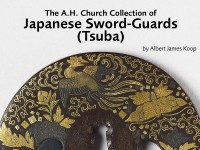The A. H. Church Collection of Japanese Sword-Guards (Tsuba)
An unpublished catalogue of the A. H. Church collection of Japanese sword-guards (tsuba) by Albert James Koop.

Nara Toshinga I [Japanese text], b. 1667, d. 1737, a pupil of the Ko-Kara, at first followed their somewhat restricted canons, but leaped into prominence by breaking away from their traditions. Besides developing far more refinement, he displays a greater knowledge of human anatomy. Historical and legendary subjects find favour with him, and he originates the continuing of the relief over the edge of a guard or kodzuka. He also employs a more extended range of metals and alloys to animate his reliefs. His style was followed by his son Toshinaga II and several pupils.
Notice
Object information may not accurately reflect the actual contents of the original publication, since our online objects contain current information held in our collections database. Click on 'buy this publication' to purchase printed versions of our online publications, where available, or contact the Jameel Study Centre to arrange access to books on our collections that are now out of print.
© 2013 University of Oxford - Ashmolean Museum






